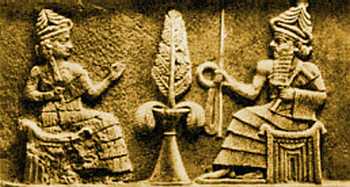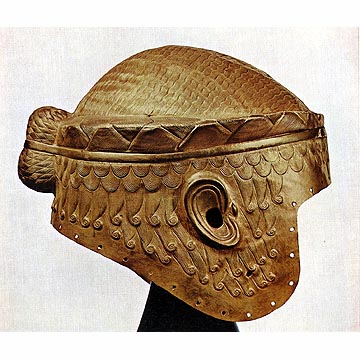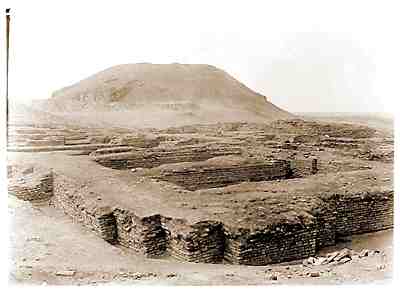Updated March 30th 2020
Genesis 10:10 Genesis 11:2 : The Sumerians may have migrated from the East -- either ancient India or Iran -- and were unrelated on the basis of their language to the various groups speaking Semitic languages in theAncient Near East (F) ... Sumer may very well be the first civilization in the world (although long term settlements atJericho andCatal Hoyuk predate Sumer and examples of writing fromEgypt may predate those from Sumer). From its beginnings as a collection of farming villages before 5000 BC through its conquest by Sargon (Sharrukin) of Agade (Akkad) around 2370 BC and its final collapse from theAmorite invasion around 2000 BC the Sumerians developed a religion and a society which influenced both their neighbors and their conquerers. Sumerian cuneform -- the earliest written language -- was borrowed by theOld Babylonian Kingdom which also took many of their religious beliefs (A) ... : Sumer was a collection of city-states around the Lower Tigris and Euphrates Rivers in what is now southern Iraq. Each of these cities had individual rulers although as early as the mid fourth millennium BC the leader of the dominant city-state was considered to have been the king of the region (ibid). Although evidence for human presence exists in western Asia far back into paleolithic times theprehistory of southern Iraq is relatiely late in coming; there are no archaeological remains preceding the sixth millennium BC (1) Thehistory of Sumer tends to be divided into five periods. They are theUruk Period -- which saw the dominance of the city-state of that same name -- theJemdet Nasr Period -- the Early Dynastic Periods (2900-2370 BC) -- the Akkadian Period --Ur III Period; the entire span lasting from circa 3800 to 2000 BC (A) :The earliest settlement of the southern alluvial flood plain in the late 6th millennium (G) was by a non-Semitic people called proto-Euphrateans (H). This prehistoricUbaid Culture had a long duration beginning before 5000 BC and lasting until the beginning of the Uruk Period. In the mid-5th millennium BC the Ubaid Culture spread into northernMesopotamia and replaced theHalaf Culture. It is characterised by large village settlements and the appearance of the first temples in Mesopotamia. The Ubaid Culture developed as a result of increasing sophistication in irrigation techniques. Ubaid pottery was more austere in form and decoration than that of the Halaf. Thus the distinctive types of pottery serve todelineatestrigraphic layers and cultures as well. This culture is properly divided into two phases which both precede and are also regarded as proto-Ubaidian; the earlierEridu and laterHajji Muhammed ... The earliest known settlement in Sumer however has been excavated at the small site Tell (mound) Oueili. The lowest levels of this hamlet are earlier than the hitherto attested phases of the Ubaid Culture. The culture to which thisOueili Phase is linked is unknown but certain architectural similarities suggest a connection with theHassunan Culture ofSamarra (1) ... French excavations at Tell Oueili (J.-L. Huot) nearLarsa have revealed a predecessorUbaid 0 occupation which appears to be derived from the Samarran Culture (B45) ... The Ubaid Period in Lower Mesopotamia was particularly critical because it immediately preceded urbanization (1) ... The stretched from 3800 to 3200 BC. This time saw an enormous growth in urbanization with impressive structures and the earliest evidence of writing. Uruk probably had a population of around 45000 at the end of the period. Irrigation innovations as well as a supply of raw materials for craftsmen provided an impetus for this growth. In fact the city-state of Uruk also seems to have been at the heart of a trade network which stretched from southern Turkey to eastern Iran (A) ... It remained in occupation throughout the following two millennia until theParthian Period at which time it was only a minor centre ... The lasted from 3200 to 2900 BC. This city-state gave its name to a distinctive wheel-turned painted pottery (K) ... The period represents the transition from prehistory to history and literate civilization [urban revolution] ... Occupation commences in the Ubaid Period (circa 4000 BC) and flourishes from 3400 to 2800 BC during the Late Uruk -- Jemdet Nasr -- Early Dynastic I Periods. This period was a time ofretrenchment [anti-expansionism] and relative cultural isolation in southern Mesopotamia. In sum the material culture of Jemdet Nasr reflects the consolidation of administrative and social developments in the centuries following the invention of Proto-cuneiform writing in the Late Uruk Period in southern Mesopotamia. These developments were to underpin the spectacular achievements of Sumerian civilization in the succeeding Early Dynastic Period (1) ...
... The SumerianKing List names eightantediluvian kings who reigned for tens of thousands of years but it is not known if these names have any historical basis. TheRoyal Tombs of Ur contain the graves of Meskalamdug and Akalamdug -- among others -- which probably date to this period (L) ... ... According to the King Lists the first dynasty after the Great Flood (recorded in theGilgamesh Epic) was the 1st Dynasty ofKish. The last two kings -- Enmebaragesi and Agga -- are the first rulers attested in contemporary inscriptions. According to the King Listkingship orLugal then passed on to the 1st Dynasty of Uruk which included Enmerkar -- Lugalbanda -- Gilgamesh; heroes of epic tradition -- and then finally to the 1st Dynasty of Ur.Epigraphic evidence shows that these dynasties (and atMari on the Middle Euphrates River) were all contemporary and date to circa 27002600 BC. Many rulers known from contemporary inscriptions are not found in the King Lists. ... The King Lists record eleven more dynasties before Sargon of Akkad. Except for the 3rd Dynasty of Uruk little is known of them and many were probablycontemporaneous. By 2500 BC the city-state of Kish seems to have establishedhegemony over Sumer. Thereafter the titleKing of Kish lent preeminence to the sovereigns of later city-states seeking their supremacy acknowledged (L and Page 809-102) ... The 1st Dynasty ofLagash (Telloh) is well known from inscriptions though it is not mentioned in the King List. It started with Mesilim (circa 2550 BC) but it was Eannatum (circa 2450 BC) who conquered much of Sumer and extended Lagash's power intoElam and Mari. UruInimGina of Lagash (circa 2350 BC) was the earliest known social reformer: he established freedom oramargi in the land -- the first recorded use of the term in a political sense (L) ... The 3rd Dynasty of Uruk had only one king. LugalZagesi as King ofUmma seized Uruk and established domination over Lagash; thus taking the titleLugal over all the rulers of Sumer. He claimed to rule from the Persian Gulf to the Mediterranean -- though this is doubtful. Under his rule Akkadians began to rise to high positions in government. The population of Mesopotamia probably reached half a million in this period. He was defeated and replaced by Sargon -- whose rise ushered in a new phase of Mesopotamian history that saw for the first time the political unification of Sumer and Akkad (L and Page 809-102) ... ... The Akkadians are a Semitic-speaking people who lived in the northern part of what was later to be called Babylonia beginning with theaccession ofHammurabi. Theperiod usually refers to the 141 years circa 2334-2193 BC defined by the reign of the five kings of the Sargonic Dynasty. The area extended from north of Nippur toSippar. Some scholars add another 40 years to this period (see below) to include the 2 later kings of the city-stateAgade -- which has not yet been found by archaeologists. Sargon wasKing of Kish which impliedsuzerainty over northern Babylonia when he defeated the principal ruler in Sumer -- King Lugalzagesi of Uruk (1) thus uniting the non-Semitic Sumer with the more northerly Akkad under one kingship ... The actual Sargonic Dynasty ended with SharKaliSharri in 2193 BC. The collapse of the embattled state of Akkad may have been the result of internal weaknesses and rebellion and foreign attack especially -- according to Sumerian tradition -- theGutians (ibid) of the Zagros Moutains on the Iraq-Iran border ... They then subjugated and laid waste the whole of Sumer (C). With the collapse of the Akkadian Empire the land lost its common leadership and collective power. The wild Gutian hordes were not very qualified for the leadership so the individual cities in Sumer and Akkad fell back to the old city-state (D) localized hegemony ... The now obscure and impotent Akkadian Dynasty survived for another 40 years in name only with Dudu and ShuDurul as kings but there realm was limited to the region of the capital. The instumental role of the Gutian tribes in the fall of Akkad is uncertain. It seems more likely that they filled the vaccuum created by the decay of the empire (Page 8112) ...
The city-state ruler who finally achieved a temporary supremacy and whose dynasty was in some senses the heir to the Third Dynasty of Ur was IshbiErra ofIsin. Larsa alternated with Isin in controlling southern Mesopotamia in the first two centuries of the 2nd millennium BC. Neither state could properly be regarded as sole legitimate ruler of Babylonia (ibid) ... It is clear that the migrations of the Amorites toward the end of the Third Dynasty of Ur played a role in the collapse of the empire yet some historians have rightly pointed to evidence of growing internal decay in the period before the invaders destroyed this political entity Under the Third Dynasty of UrBabylon had been a small city-state ruled by anEnsi. The founder of the First Dynasty -- Sumu-Abum -- was of West Semitic origin (Excerpt 60) ... : Sumerian is a linguistically isolated and extinct language. All attemts to connect Sumerian with any other tongue have so far failed. Sumerian is preserved only on clay tablets in a considerablecorpus of texts written in cuneiform. After 2000 BC the Semitic language Akkadian became dominant (lingua franca) and Sumerian was relegated to the status of a literary language (1) ... Citations: (1)History and Legend In the Ancient World by Daniel Zimmermann (2015) (2) Pages xiii-xiv inWhy Government Can Never Fix a Down Economy by Tom Shipley (2012) (3)God and Dreams: Is There a Connection? by John Pratt Bingham (2010) under Mark Alan McDonald |
[8]ページ先頭



 ... Sumer was divided between some thirty city-states each with a patron deity and a ruler generally calledEnsi. They shared a set of religious beliefs that recognized the supremacy of the patron deity Enlil of
... Sumer was divided between some thirty city-states each with a patron deity and a ruler generally calledEnsi. They shared a set of religious beliefs that recognized the supremacy of the patron deity Enlil of